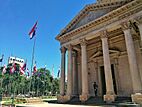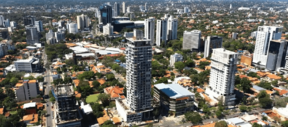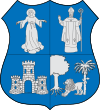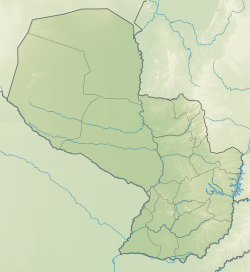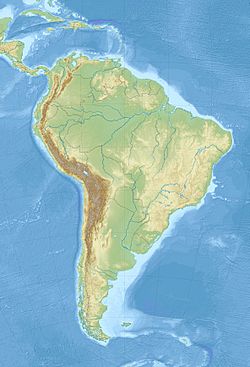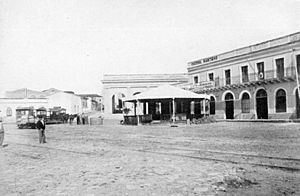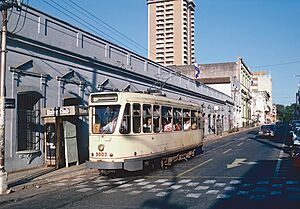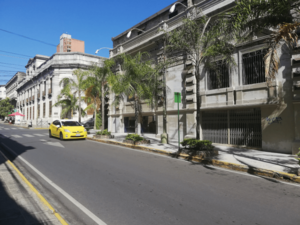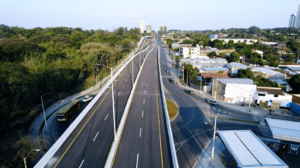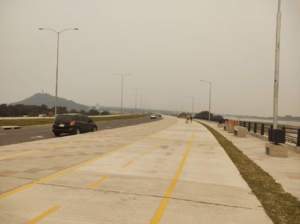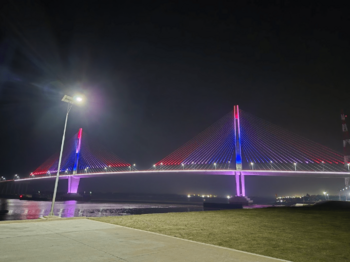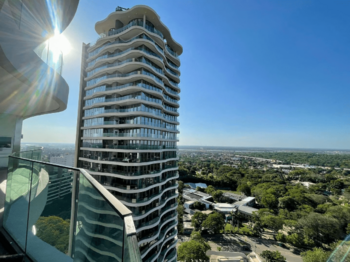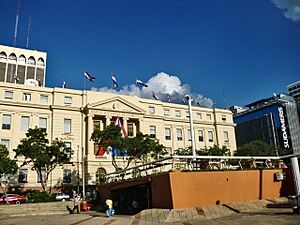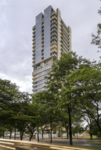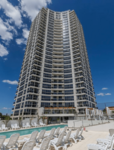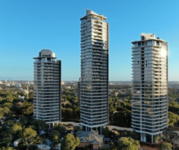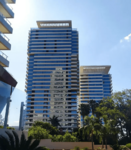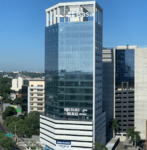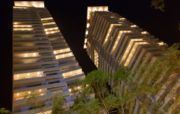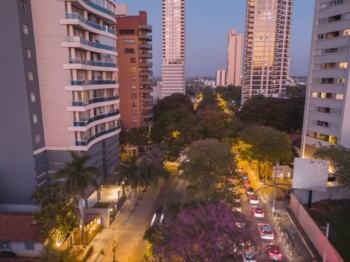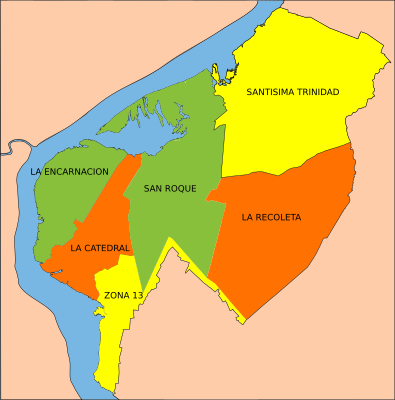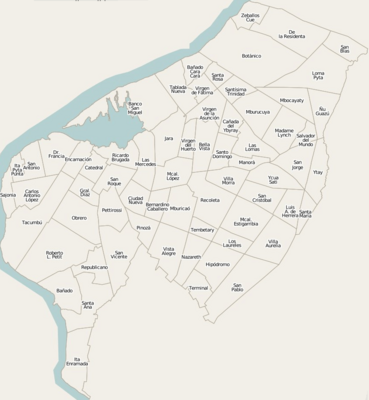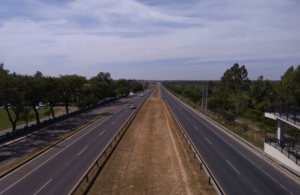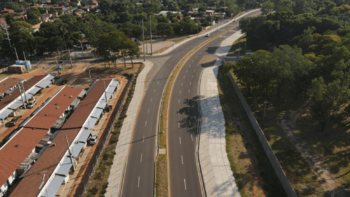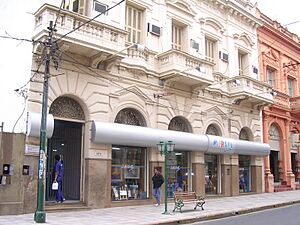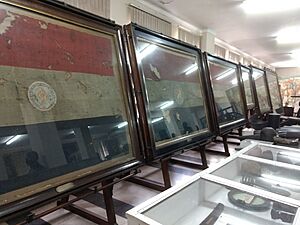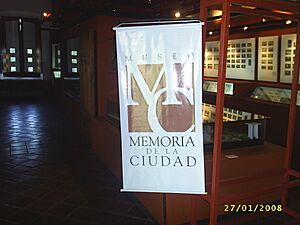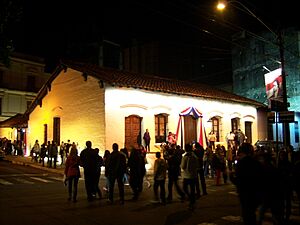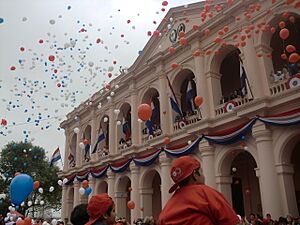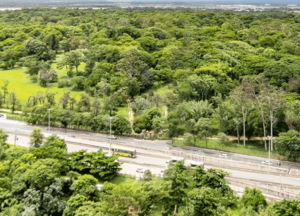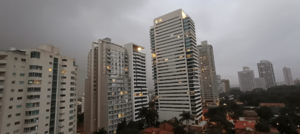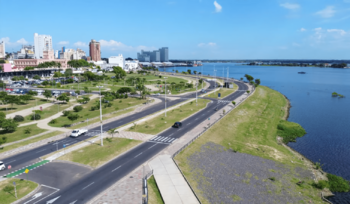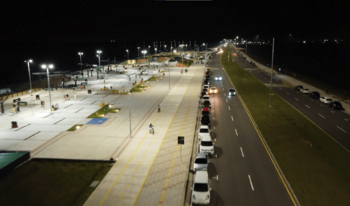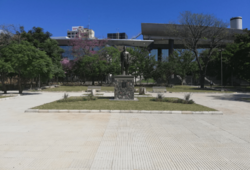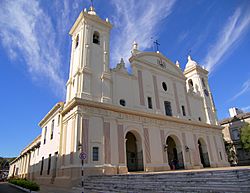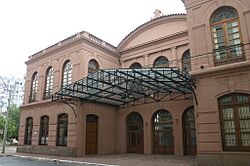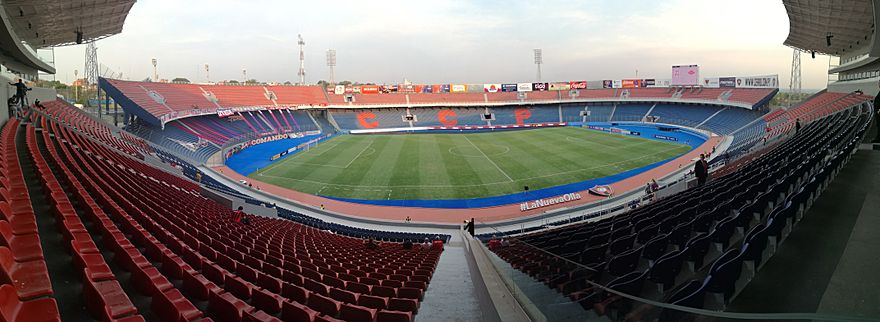Asunción facts for kids
Quick facts for kids
Asunción
Nuestra Señora Santa María de la Asunción
|
|||
|---|---|---|---|
|
Capital city and district
|
|||
|
Skyline of Old town Asunción
Palace of the López
Skyline of the corporate-residential axis
Monument of the Paraguayan harp
Héroes del Chaco Bridge
|
|||
|
|||
| Nickname(s):
The Mother of Cities, The World's Capital of Friendship.
|
|||
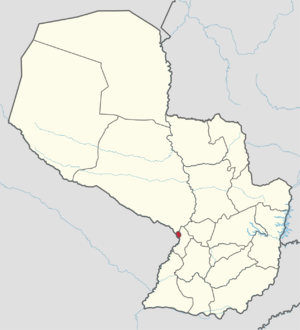
The Capital District in Paraguay
|
|||
| Country | |||
| District | Capital District | ||
| Founded | 15 August 1537 | ||
| Named for | Assumption of Mary | ||
| Area | |||
| • Capital city and district | 117 km2 (45.2 sq mi) | ||
| • Metro | 1,035 km2 (400 sq mi) | ||
| Elevation | 43 m (141 ft) | ||
| Population
(2022)
|
|||
| • Capital city and district | 462,241 | ||
| • Metro | 2,346,168 | ||
| Demonym(s) | Asunceno, -a | ||
| GDP (PPP, constant 2023 values) | |||
| • Year | 2023 | ||
| • Total (Metro) | $64.7 billion | ||
| • Per capita | $18,800 | ||
| Time zone | UTC−04:00 (Paraguay Time) | ||
| • Summer (DST) | UTC−03:00 (Paraguay Summer Time) | ||
| Postal code |
001001–001535
|
||
| Area code(s) | +595 (21) | ||
| Climate | Cfa | ||
Asunción (pronounced ah-soon-see-OWN) is the capital and largest city of Paraguay. It sits on the eastern bank of the Paraguay River. The river and the Bay of Asunción separate it from western Paraguay and Argentina. The rest of the city is surrounded by the Central Department.
Asunción is one of the oldest cities in South America. It's known as "the Mother of Cities" because many Spanish expeditions started here. These expeditions went on to found other important cities like Buenos Aires and Santa Fe. In 2022, Asunción had about 462,241 people. Its larger metropolitan area, called Greater Asunción, has over 2.3 million people. This makes it the most populated and productive area in Paraguay.
The city is a special capital district. It's not part of any department. The Greater Asunción area includes nearby cities like San Lorenzo and Luque. Asunción is a great place for investments and has seen a lot of economic growth. It is where the main government offices are located. It's also a cultural hub for the country.
Asunción is in a good spot for trade in South America. It's close to big cities like Buenos Aires and Montevideo. This location helps its economy grow. The city is known as a "Gamma City" by a global research group. It's also considered one of the cheapest cities for visitors and one of the safest capitals in Latin America.
Contents
What's in a Name?
The full name of the city is "Nuestra Señora de la Asunción." This means "Our Lady of the Assumption." The fort that became the city was founded on August 15, 1537. This was the day the Catholic Church celebrates the Assumption of Mary. The word "Asunción" comes from a Latin word meaning "the Virgin Mary being lifted body and soul to heaven."
A Look Back in Time
Early Days
The Spanish explorer Juan de Ayolas might have visited this area first. He was looking for a way to the mines in what is now Bolivia. Later, Juan de Salazar y Espinosa founded a fort here in August 1537. He named it Nuestra Señora Santa María de la Asunción.
In 1542, people from Buenos Aires moved to Asunción after their city was attacked. This made Asunción a very important Spanish center. It controlled a large area that included parts of Brazil, Paraguay, and Argentina. In 1603, a meeting in Asunción decided how to teach Christianity to the native people in their Guaraní language.
In 1731, there was an early uprising against Spanish rule led by José de Antequera y Castro. Even though it failed, it showed that people in Paraguay wanted to be independent. This spirit led to Paraguay's independence in 1811. The secret meetings to plan the revolution happened at Juana María de Lara's house in Asunción. Today, this house is a museum called Casa de la Independencia.
After Independence
After Paraguay became independent, Asunción changed a lot. Under Gaspar Rodríguez de Francia, roads were built. Later, President Carlos Antonio López brought even more progress. Over 400 schools, metal factories, and South America's first railroad were built.
After López died, his son Francisco Solano López became president. He led the country through the terrible Paraguayan War (1864–1870). Brazilian forces took over Asunción in 1869 and stayed until 1876. Many historians say this war caused a big decline for the city and country.
After the war, Asunción slowly started to recover. In the late 1800s and early 1900s, many immigrants came from Europe and the Middle East. This helped the city grow again, with new buildings and a more prosperous time. A tram system opened in 1871, first with horse-drawn trams, then electric ones in 1913. The tram system stopped running around 1995.
Modern Times
From 1932 to 1935, Paraguay fought the Chaco War with Bolivia. Asunción became a place to help the wounded. The Defensores del Chaco stadium is named because soldiers for the war were recruited there.
Asunción became a fully urban city by the mid-1900s. Until the 1980s, it was the only city in Paraguay with over 100,000 people. Then, many people started moving from rural areas to the cities. This made the population of Asunción's surrounding areas grow a lot.
In 1991, the Treaty of Asunción was signed here. This created Mercosur, a group for regional trade and cooperation. Since 1993, Asunción has been an independent city, not part of any department.
Today, Asunción faces challenges like heavy traffic. But many new investments are happening, making it one of the fastest-growing cities in the region. New transportation projects like a metrobus or electric train are being planned.
Where is Asunción?
Asunción is located between 25° 15' and 25° 20' south latitude and 57° 40' and 57° 30' west longitude. It sits on the left bank of the Paraguay River. The river and the Bay of Asunción separate the city from western Paraguay and Argentina. The rest of the city is surrounded by the Central Department.
The Paraguay River is very important for the city. It's used for trade and is also a tourist spot. The Bay of Asunción is separated from the river by a narrow strip of land called the San Miguel Bank. This area is where two different natural regions of Paraguay meet.
Asunción has an uneven landscape with "seven hills." The old part of the city is on a hill. The highest point in Asunción is Cerro Lambaré, which is 156 meters (512 feet) above sea level. It has a small forest and looks beautiful in spring when the lapacho trees bloom.
The 7 hills of Asunción are:
- Loma Cabará, where Asunción was founded.
- Loma San Jerónimo, where a small church once stood.
- Loma Clavel, where military barracks are now.
- Loma Cachinga, where a hospital is now.
- Loma del Mangrullo, where Carlos Antonio López Park is now.
- Loma de la Encarnación, where the Church of the Encarnación is now.
- Loma de las Piedras de Santa Catalina, where a staircase is now.
Mount Tacumbú was another important hill, but it was used for rocks to pave streets. Now, only a lagoon remains.
Nature in the City
Asunción has two main natural areas: the bay area and the inner city area. The inner city used to have thick forests with trees over 40 meters (130 feet) tall. Some common trees were the pink lapacho and cedar.
Large animals like jaguars and tapirs once lived here. Today, you can still find smaller animals like toucans, opossums, and various birds in the Botanical Garden and Zoo of Asunción and around Cerro Lambare. In busy city areas, you might see cardinals and doves.
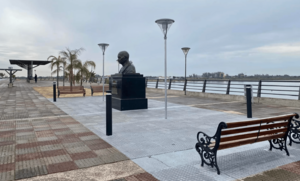
The bay area is about 375 hectares (927 acres) and is important for migratory birds. Many birds from North and South America stop here. The water level in the bay changes a lot throughout the year. When the water is high, the bay is mostly underwater. When it drops, sandy beaches and grasslands appear. Over 250 bird species have been seen here, making it an Important Bird Area.
Weather in Asunción
Asunción has a humid subtropical climate. This means it has hot, humid summers and mild winters. The average temperature in January (summer) is 27.5°C (81.5°F). In July (winter), the average is 17.6°C (63.7°F). It's humid all year, so summer can feel even hotter. The average yearly temperature is 23°C (73°F).
Summers are hot and humid, with temperatures sometimes going over 40°C (104°F). January is the hottest month. There's a lot of sunshine and often short summer storms. Winters are mild and can vary. Some days are cold, around 0°C (32°F), while others can be warm, around 30°C (86°F). Frost can happen in the suburbs.
It rains a lot throughout the year, with frequent storms. The driest months are June, July, and August. Snow is very rare; the last time it snowed was in 1751.
| Climate data for Asunción (1991–2020, extremes 1991–present) | |||||||||||||
|---|---|---|---|---|---|---|---|---|---|---|---|---|---|
| Month | Jan | Feb | Mar | Apr | May | Jun | Jul | Aug | Sep | Oct | Nov | Dec | Year |
| Record high °C (°F) | 42.0 (107.6) |
40.8 (105.4) |
41.6 (106.9) |
37.8 (100.0) |
35.0 (95.0) |
33.6 (92.5) |
35.6 (96.1) |
39.4 (102.9) |
42.2 (108.0) |
43.0 (109.4) |
41.2 (106.2) |
41.7 (107.1) |
43.0 (109.4) |
| Mean daily maximum °C (°F) | 34.0 (93.2) |
33.0 (91.4) |
31.9 (89.4) |
29.2 (84.6) |
24.9 (76.8) |
23.5 (74.3) |
23.6 (74.5) |
26.2 (79.2) |
27.9 (82.2) |
30.1 (86.2) |
31.2 (88.2) |
32.8 (91.0) |
29.0 (84.2) |
| Daily mean °C (°F) | 27.8 (82.0) |
26.9 (80.4) |
25.9 (78.6) |
23.2 (73.8) |
19.4 (66.9) |
18.3 (64.9) |
17.5 (63.5) |
19.6 (67.3) |
21.5 (70.7) |
24.1 (75.4) |
25.2 (77.4) |
26.9 (80.4) |
23.0 (73.4) |
| Mean daily minimum °C (°F) | 23.1 (73.6) |
22.5 (72.5) |
21.5 (70.7) |
18.9 (66.0) |
15.5 (59.9) |
14.2 (57.6) |
12.9 (55.2) |
14.6 (58.3) |
16.5 (61.7) |
19.5 (67.1) |
20.3 (68.5) |
22.2 (72.0) |
18.5 (65.3) |
| Record low °C (°F) | 12.5 (54.5) |
12.4 (54.3) |
9.4 (48.9) |
6.5 (43.7) |
2.6 (36.7) |
−1.2 (29.8) |
−0.6 (30.9) |
0.0 (32.0) |
2.6 (36.7) |
7.0 (44.6) |
7.8 (46.0) |
10.0 (50.0) |
−1.2 (29.8) |
| Average precipitation mm (inches) | 132.6 (5.22) |
146.4 (5.76) |
131.3 (5.17) |
151.7 (5.97) |
134.1 (5.28) |
70.7 (2.78) |
48.2 (1.90) |
38.7 (1.52) |
79.2 (3.12) |
157.9 (6.22) |
195.0 (7.68) |
176.5 (6.95) |
1,462.3 (57.57) |
| Average precipitation days (≥ 1.0 mm) | 8 | 7 | 7 | 8 | 7 | 7 | 4 | 5 | 6 | 8 | 8 | 8 | 83 |
| Average relative humidity (%) | 68 | 71 | 72 | 75 | 76 | 76 | 70 | 70 | 66 | 67 | 67 | 68 | 70 |
| Mean monthly sunshine hours | 276 | 246 | 254 | 228 | 205 | 165 | 195 | 223 | 204 | 242 | 270 | 295 | 2,803 |
| Source 1: World Meteorological Organization (precipitation days 1971–2000) NOAA (extremes) | |||||||||||||
| Source 2: NOAA updated to 9/2012 (humidity, record 1961–1990), Danish Meteorological Institute (sun only) | |||||||||||||
Money and Jobs
Asunción's economy has grown quickly in recent years. This is because many foreign companies are investing here. The city is ranked as one of the most profitable in Latin America. Most major companies and businesses have their main offices in Asunción. Shopping areas have also expanded into the suburbs. The only stock exchange in Paraguay, the BVPASA, is located here. Asunción is the main economic center of Paraguay.
The city has simple tax rules for investments. There are no income taxes for people who invest in the Asunción Stock Exchange. These rules attract a lot of foreign money. Experts say Paraguay is one of the best countries in Latin America for investments. It has laws that protect important investments and help big factories and building projects.
Most people in Asunción work in services and commerce. About 8 out of 10 people work in these areas. About 16% work in industry and construction. Very few people work in farming, as Asunción is a city. Commerce has grown a lot, moving from the old downtown to new shopping malls in residential areas.
Many international banks have offices in Asunción, like Citibank and BBVA. Paraguayan banks like the National Development Bank are also here. The Central Bank of Paraguay is in Asunción. Its job is to keep the country's money stable and ensure the financial system works well.
A study in 2022 found that Asunción is the third cheapest city in Latin America for foreign visitors.
New Buildings and Growth
Real estate in Asunción is growing fast. This is because of low inflation, stable money, good rental income, and lower taxes. Many new buildings are smart and use modern technology. Between 2015 and 2020, over $1 billion was invested in new buildings. A lot of this growth happened along Aviadores del Chaco Avenue and Santa Teresa Avenue.
This growth is also due to people wanting more comfortable and modern homes. Many young professionals are choosing to live in apartments. They look for comfort, good locations, security, and quality. Paraguay's middle and upper-middle classes have more money to spend. This has led them to buy homes in areas near the city where new offices have opened.
Learning and Schools
Schools
Asunción has many public and private schools. Some well-known public schools are Colegio Nacional de la Capital (founded in 1877), Colegio Técnico Nacional, and Colegio Nacional Presidente Franco. Popular private schools include American School of Asunción, Colegio San José, and Colegio Goethe.
Universities
The main universities are the Universidad Americana and the Universidad Nacional de Asunción (a state university). The Universidad Nacional de Asunción was founded in 1889 and has over 40,000 students. The Universidad Católica Nuestra Señora de la Asunción was founded in 1960 and has about 21,000 students. The National University's main campus is in San Lorenzo, a city near Asunción. There are also several smaller private universities.
People of Asunción
In 2022, Asunción had 462,241 people. This means about 8% of Paraguay's population lives here. The Greater Asunción area has over 2.3 million people, which is about 40% of Paraguay's population. It's the most populated city in the country. About 1.5 million people and 600,000 vehicles move through Asunción every day.
The city's population more than doubled between 1962 and 1992. Asunción is still the only city in Paraguay with almost 500,000 people. Since the late 1990s, the city's population has stayed about the same. This is because many new people have moved to the cities around Asunción. Land is cheaper there, taxes are lower, and it's easy to get to the capital.
More women live in Asunción than men. This is common in cities because there are often more job opportunities for women. For every 100 women, there are about 89 men. The average age in Asunción is 31, which is older than the national average of 27. Asunción is known as a multicultural city.
Beliefs
About 90% of people in Asunción are Catholic. The Roman Catholic Archdiocese of Asunción covers the city and surrounding areas. There are also places of worship for other Christian groups, as well as Islam, Buddhism, and Judaism.
Languages
Most people in Asunción speak either Paraguayan Spanish (56.9%) or Guaraní (11.2%) as their main language. About 27.4% speak Jopará, which is a mix of Guaraní and Spanish words. Other languages are spoken by 4.5% of the population.
| Historical population | ||
|---|---|---|
| Year | Pop. | ±% |
| 1950 | 206,634 | — |
| 1962 | 288,882 | +39.8% |
| 1972 | 388,958 | +34.6% |
| 1982 | 454,881 | +16.9% |
| 1992 | 500,938 | +10.1% |
| 2002 | 512,112 | +2.2% |
| 2012 | 529,433 | +3.4% |
| 2022 | 462,241 | −12.7% |
Population by sex and age according to the 2002 census
| Age | Quantity (census 2002) | Male | Female |
|---|---|---|---|
| 0–4 years | 45,382 | 23,058 | 22,374 |
| 5–9 years | 46,120 | 23,330 | 22,324 |
| 10–14 years | 46,272 | 22,985 | 23,287 |
| 15–29 years | 155.675 | 71,885 | 83,790 |
| 30–59 years | 164,367 | 75,871 | 88,496 |
| 60+ years | 54,296 | 21,686 | 32,610 |
| Total | 512,112 | 238,815 | 273,297 |
City Areas and Neighborhoods
Asunción is divided into districts, and these districts contain different neighborhoods.
| N.º | Neighborhood | District | N.º | Neighborhood | District | N.º | Neighborhood | District | N.º | Neighborhood | District |
|---|---|---|---|---|---|---|---|---|---|---|---|
| 1 | Banco San Miguel | San Roque | 2 | Bañado Cará Cará | Trinidad | 3 | Bella Vista | Trinidad | 4 | Botánico | Trinidad |
| 5 | Cañada del Ybyray | Trinidad | 6 | Carlos A. López | La Encarnación | 7 | Carmelitas | Trinidad | 8 | Catedral | La Catedral |
| 9 | Ciudad Nueva | San Roque | 10 | Dr. Francia | La Encarnación | 11 | La Encarnación | La Encarnación | 12 | Gral. Caballero | San Roque |
| 13 | Gral. Díaz | La Catedral | 14 | Herrera | La Recoleta | 15 | Hipódromo | La Recoleta | 16 | Itá Enramada | Santa María |
| 17 | Itá Pytã Punta | La Encarnación | 18 | Jara | San Roque | 19 | Jukyty | Santa María | 20 | Los Laureles | La Recoleta |
| 21 | Loma Pytá | Trinidad | 22 | Madame Lynch | Trinidad | 23 | Manorá | Trinidad | 24 | Mcal. Estigarribia | La Recoleta |
| 25 | Mcal. López | San Roque | 26 | Mbocayaty | Trinidad | 27 | Mburicaó | San Roque | 28 | Mburucuyá | Trinidad |
| 29 | Las Mercedes | San Roque | 30 | Nazareth | La Recoleta | 31 | Ñu Guazú | Trinidad | 32 | Obrero | La Catedral |
| 33 | Pinozá | San Roque | 34 | Recoleta | La Recoleta | 35 | Republicano | Santa María | 36 | Ricardo Brugada | San Roque |
| 37 | Roberto L. Pettit | La Catedral | 38 | Sajonia | La Encarnación | 39 | Salvador del Mundo | Trinidad | 40 | San Antonio | La Encarnación |
| 41 | San Blas | Trinidad | 42 | San Cayetano | La Catedral | 43 | San Cristóbal | La Recoleta | 44 | San Jorge | La Recoleta |
| 45 | San Juan | San Roque | 46 | San Pablo | La Recoleta | 47 | San Roque | San Roque | 48 | San Vicente | San Roque |
| 49 | Santa Ana | La Catedral | 50 | Santa Librada | Santa María | 51 | Santa María | La Recoleta | 52 | Santa Rosa | Trinidad |
| 53 | Trinidad | Trinidad | 54 | Santo Domingo | Trinidad | 55 | Silvio Pettirossi | San Roque | 56 | Tablada Nueva | Trinidad |
| 57 | Tacumbú | La Encarnación | 58 | Tembetary | La Recoleta | 59 | Terminal | La Recoleta | 60 | Villa Aurelia | La Recoleta |
| 61 | Villa Morra | La Recoleta | 62 | V. de Fátima | Trinidad | 63 | V. de la Asunción | Trinidad | 64 | V. del Huerto | San Roque |
| 65 | Vista Alegre | San Roque | 66 | Ycuá Satí | La Recoleta | 67 | Ytay | La Recoleta | 68 | Zeballos Cué | Trinidad |
City Life and Services
Asunción has the main political, economic, and cultural buildings in Paraguay. The city started to grow a lot in the late 1800s. Europeans helped rebuild the city with many new buildings and mansions. These old buildings are protected today. Almost everyone in the city has access to clean drinking water and electricity.
Roads and Getting Around
The city's roads have not changed much over time. The main ways to get into the city are large avenues, highways, and overpasses. In the past, electric trams were used for transport, but now buses are common. There were plans for a metrobus and an electric train to connect the capital with nearby cities, but these projects stopped.
Mariscal López Avenue connects Asunción with Fernando de la Mora. General Santos Avenue is another important road. Eusebio Ayala Avenue is used a lot by buses during busy times. The Acceso Sur overpass leads to the Mercado de Abasto, a big market. Madame Lynch Avenue goes around the eastern part of the city. Aviadores del Chaco Avenue is a key road from Luque and leads to the airport. The Ñu Guazú highway connects Luque and Mariano Roque Alonso with Asunción.
Transportation
Because the Paraguay River is right next to Asunción, the city has a river port downtown. This port is important for goods entering and leaving the country. There's also a smaller port in the Sajonia neighborhood.
Public transportation uses buses, called colectivos or micros. They go to all parts of the city and nearby towns. Since October 2020, you need an electronic card to use these buses. There are two cards: "Jaha" (meaning Let's Go in Guaraní) and "Más" (meaning More in Spanish).
The main long-distance bus station is the Terminal de Ómnibus de Asunción (TOA). Buses from here connect to all parts of Paraguay and to nearby countries like Argentina and Brazil. About 115 companies offer over 1,300 trips daily. Up to 55,000 passengers leave daily, especially during holidays.
Silvio Pettirossi International Airport is Paraguay's main airport. It's located in Luque, a suburb of Asunción. It's the busiest airport in Paraguay.
Ride-sharing services like Bolt and Uber are available. They compete with taxi companies. Most payments for daily needs, including transport, are made with cash.
Healthcare
Asunción has most of the country's large medical centers. There are over 50 places that offer basic healthcare. Public healthcare is free and run by the government. This means more people can get medical help, from simple check-ups to complex surgeries.
There are also important private hospitals and clinics. Some well-known ones include the Medical Emergency Center and the Clinic Hospital.
Safety
Asunción used to not have its own police force. The National Police handled all public safety. However, in 2010, the city created its own Municipal Police of Asunción. It currently has 52 police officers.
City Projects
Homes for Families
New projects like "Avenida Costanera Norte" and "Parque Bicentenario" have created a new neighborhood. It has 144 homes for families who were affected by city improvement plans. This project included building homes and other services for these families.
Coastal Park
A coastal park of about 13 hectares (32 acres) was built. This park connects old city buildings like the Palacio de los López with the Cabildo and Metropolitan Cathedral. It opened in May 2011, celebrating Paraguay's 200 years of independence.
Work continued on the "Parque Lineal Costanera" project. The first part opened in late 2019. It has bike lanes, walking paths, gym equipment, and parking for 350 cars. The second part will add 10 more hectares (25 acres) of green space. It will include wider bike paths, more parking, playgrounds, outdoor gyms, and police booths.
Culture and Fun
Asunción is the third-oldest capital city in South America. It has a rich culture with many things to see and do. You can find old Spanish colonial buildings, museums, and parks. The city also has several symphony orchestras, ballet, opera, and theater groups.
Famous orchestras include the City of Asunción's Symphony Orchestra. Well-known ballet companies are the Asunción Classic and Modern Municipal Ballet. The main opera company is the Northern University Opera Company. Important theaters include the Municipal Theater and the Paraguayan-Japanese Center. The Jockey Club (Asunción) is a major concert venue. Asunción is also the center of Architecture in Paraguay.
Museums to Explore
Asunción has many small museums that show the country's history and art. Here are some of them:
- Juan Sinforiano Bogarín Museum: This museum has a collection of old religious carvings. It used to be a prison.
- Casa de la Independencia Museum: Built in 1772, this house was where Paraguay's independence was planned. It has items from that time.
- Postal Historical Museum: Located in the Central Post Office, it has a collection of stamps from around the world.
- National Museum of Fine Arts: Opened in 1909, it has many paintings, sculptures, and historical documents.
- Museum of Memories "Dictatorship and Human Rights": This museum tells the stories of victims from a past dictatorship.
- Doctor Andrés Barbero Ethnographic Museum: It has a collection of items from indigenous groups in Paraguay.
- General Bernardino Caballero National Historical Museum: This museum is in the house where Bernardino Caballero lived. You can see his furniture and personal items.
- Paraguayan Touring and Automobile Club Museum: It shows old cars from Paraguay, including the oldest car in the country.
- Institute of History and Military Museum: This museum has many items from Paraguay's military history.
- Numismatic Museum of the Central Bank: It shows the history of money in Paraguay. It also has jewels from the War of the Triple Alliance.
- Visual Arts Center or Clay Museum: This museum shows popular, indigenous, and modern art from Paraguay. It has over 4,000 pieces, including wood carvings and ceramics.
- Manzana de la Rivera: This is a group of nine old houses built at different times. The oldest one is from the 1700s. One house is now the City Memory Museum.
- Metropolitan Cathedral Treasure Museum: It has a collection of sacred art, clothing, and other religious items.
- Mariscal José Félix Estigarribia Museum: This museum has uniforms, weapons, and other military items.
- House of Paraguayan Culture: It protects objects and documents from Paraguay's military history.
- Paraguayan Union of Veterans of the Chaco War: It has trophies and photos from the Chaco War.
- Museum of Sacred Art: This museum has a collection of religious sculptures and metalwork.
A Green City
Asunción was named the "Green Capital of Ibero-America" in 2010. This was because the city met seven important goals for being green. These goals included having enough green spaces, planting trees, managing waste well, and having good public transportation.
Seven Treasures of Asunción
In 2009, people voted for the "seven treasures of cultural heritage" in Asunción. Over 12,000 people voted. The chosen treasures are:
- Palacio de los López
- National Pantheon of the Heroes
- The Cabildo
- The Metropolitan Cathedral
- The Guaraní Hotel
- The Municipal Theater
- The Church of the Holy Trinity
Things to See and Do
Asunción has many famous places to visit. These include the Godoy Museum and the National Museum of Fine Arts. You can also see the Church of La Encarnación, the Metropolitan Cathedral, and the National Pantheon of the Heroes. The Pantheon is like a smaller version of Les Invalides in Paris. It holds the remains of many national heroes.
Other important landmarks are the Palacio de los López and the Casa de la Independencia. The Casa de la Independencia is one of the few old colonial buildings left.
Calle Palma is the main street downtown. It has many historic buildings, plazas, shops, and cafes. The "Manzana de la Rivera" is a group of old homes that have been restored. They show how the city's architecture has changed. The old railway station is now a museum. There are plans for a train route from here to Luque and Areguá. Near Asunción, about 30 minutes away, is a beautiful lake in San Bernardino. People go there in the summer.
Asunción also has fancy shopping malls with well-known brands. The biggest malls are Shopping del Sol, Mariscal López Shopping, and Shopping Villa Morra. La Galeria, opened in 2016, is now the largest mall in the country.
Hotels and Food
The hotel industry in Paraguay has grown a lot recently. This has helped the country's tourism. Between 2013 and 2017, the number of hotel beds grew by 34%. In 2017, Paraguay had a record number of international tourists. This growth is much higher than the world average.
There are over 905 hotels and places to stay in Paraguay, with 33,813 beds. In 2017, about 1.6 million foreign tourists visited, bringing in over $600 million. Most of this money was spent in Asunción.
Hotel owners are investing in Paraguay because the economy is stable. The government also supports tourism. This helps Paraguay compete as a good place for meetings and events in the region.
Places to Visit

- Old town: This area has most of the historic buildings and mansions. It runs along the bay.
- Asunción Bay: You can see old cannons here. From a viewpoint behind the Palacio de los López, you can see the city skyline and the nature around the bay. You can also take boats to Nueva Asunción for a great view of the city.
- Palacio de los López: This palace was started in the 1860s. It was meant to be the home of President Francisco Solano López, but he never lived there. Today, it's the main office for the government.
- Casa de la Independencia Museum: Built in 1772, this house was used for secret meetings that led to Paraguay's independence in 1811. It holds many important historical items.
- Municipal Theatre Ignacio A. Pane: This theater was built in the late 1800s. It became the Municipal Theater in 1939. It hosts many cultural events like plays, concerts, and ballets.
- National Pantheon of the Heroes: This chapel was started in 1863. It opened in 1936 and holds the remains of national heroes, including Marshal López.
- Cabildo Museum: This building was the first big public project of the 1800s. For many years, it was where the government's law-making body met. Since 2004, it has been an important museum.
- Asunción Metropolitan Cathedral: This cathedral was built by order of Carlos Antonio López and opened in 1845. It has a main altar covered in silver.
- Church of the Incarnation: The first stone for this church was laid in 1893. It was built after a fire destroyed the old church. It's one of the largest churches in Asunción.
- Carlos Antonio López Railway: This railway station and line opened in 1861. Paraguay was one of the first South American countries with a passenger railway. Today, it's a historical museum.
- Church of the Holy Trinity: Built in 1854, this church has a beautiful design and classical paintings on its ceiling.
- Antequera Staircase: This monument and staircase were built in tribute to the Communards. It was opened in 1928.
- Costanera de Asunción: This is a great place for families and friends to relax. You can walk, rent bikes, or enjoy beautiful sunsets. A linear park is also being built here.
- Botanical Garden and Zoo of Asunción: This is one of the city's main green areas, with over 110 hectares (272 acres) of natural forest. The zoo has almost 70 species of wild animals, mostly from South America.
- Bicentennial Astronomical Center: This center has three rooms. One is a multimedia room with a giant screen for science films. Another is a planetarium where you can see stars and constellations. The third room has computers and a library for science and astronomy research.
Media
Television
| TV Channel | Logo | Channel name | Topic | Type |
|---|---|---|---|---|
| Canal 4 | Telefuturo | Variety | Free-to-air | |
| Canal 5 | Paravisión | Variety | Free-to-air | |
| Canal 8 | C9N | Informative | Free-to-air | |
| Canal 9 | SNT | Variety | Free-to-air | |
| Canal 11 | LaTele | Variety | Free-to-air | |
| Canal 12 | Noticias PY | Informative | Free-to-air | |
| Canal 13 | Trece | Variety | Free-to-air | |
| Canal 14 | Paraguay TV | Variety and Institutional | Free-to-air | |
| Canal 18/27/57 | América PY | Variety | Pay television | |
| Canal 24 | A24 PY | Informative | Pay television | |
| Canal 50 | ABC TV | Variety | Pay television | |
| Canal 500 | Hei | Variety | Pay television | |
| Canal 507 | Tigo Sports | Sports | Pay television |
AM and FM radio
| kHz | AM radio name | City (Greater Asunción) | Topic |
|---|---|---|---|
| AM 650 kHz | Radio Uno | Asunción | Variety |
| AM 680 kHz | Radio Caritas | Asunción | Religion |
| AM 730 kHz | Radio Cardinal | Asunción | Informative, Sports |
| AM 780 kHz | Radio 1° de Marzo | Asunción | Culture |
| AM 800 kHz | Radio La Unión | Asunción | Variety |
| AM 920 kHz | Radio Nacional del Paraguay | Asunción | State-owned |
| AM 970 kHz | Radio Universo | Asunción | Informative, Sports |
| AM 1000 kHz | Radio Mil | Asunción | Variety |
| AM 1020 kHz | Radio Ñandutí | Asunción | Variety |
| AM 1080 kHz | Radio Monumental | Asunción | Variety, Sports |
| AM 1120 kHz | Radio La Deportiva | Lambaré | Sports |
| AM 1200 kHz | Radio Libre | Fernando de la Mora | Variety |
| AM 1250 kHz | Radio Asunción | Asunción | Variety |
| AM 1330 kHz | Radio Chaco Boreal | Asunción | Informative, Sports |
| AM 1480 kHz | Radio Iglesia | Asunción | Religion |
| MHz | FM radio name | City (Greater Asunción) | Topic |
|---|---|---|---|
| FM 87.7 MHz | Radio Medalla Milagrosa | Fernando de la Mora | Religion |
| FM 91.1 MHz | Estación 40 | Asunción | Musical, Magazine |
| FM 91.5 MHz | Top Milenium | Asunción | Musical |
| FM 91.9 MHz | HEi Radio | Asunción | Musical |
| FM 92.3 MHz | Radio Los 40 | Asunción | Musical |
| FM 92.7 MHz | Radio Vibras | Fernando de la Mora | Musical |
| FM 93.3 MHz | Radio Coeyú | Lambaré | Community |
| FM 93.5 MHz | Radio Vianney | Lambaré | Religion |
| FM 94.3 MHz | RQP Paraguay | Asunción | Variety |
| FM 95.1 MHz | Radio Nacional del Paraguay | Asunción | State-owned |
| FM 95.5 MHz | Rock & Pop Paraguay | Asunción | Musical |
| FM 96.5 MHz | Radio Disney Paraguay | Asunción | Juvenile, Magazine |
| FM 97.1 MHz | Radio Latina Paraguay | Asunción | Variety |
| FM 99.1 MHz | Radio Corazón | Asunción | Informative |
| FM 99.9 MHz | Radio La 100 | Asunción | Variety |
| FM 100.1 MHz | Radio Canal 100 | Villa Elisa | Variety |
| FM 100.9 MHz | Radio Montecarlo | Asunción | Culture |
| FM 101.3 MHz | Radio Farra | Asunción | Musical, Magazine, Variety |
| FM 102.7 MHz | Radio Aspen | Asunción | Magazine |
| FM 103.1 MHz | Radio Popular | Asunción | Variety |
| FM 103.7 MHz | Radio Exclusiva | Lambaré | Musical |
| FM 105.1 MHz | Radio Venus | Asunción | Informative |
| FM 106.5 MHz | Radio Palma | Asunción | Musical |
| FM 106.9 MHz | Radio Urbana | Asunción | Musical |
| FM 107.3 MHz | Radio María Paraguay | Asunción | Religion |
Sports
Football (soccer) is the most popular sport in Paraguay. Asunción is home to many important and traditional football teams. These include Olimpia, Cerro Porteño, Club Libertad, and Club Guaraní. These teams have their own stadiums and sports facilities.
The Defensores del Chaco stadium is the main football stadium in the country. It's in the Sajonia neighborhood, close to downtown Asunción. It's also used for other events like rock concerts. Asunción is also the center for rugby union in Paraguay. The Estadio General Pablo Rojas, home of Cerro Porteño, is the largest stadium in Paraguay.
The city also has important sports centers like the Ñu Guasú Park and the National Sports Secretariat. These places have basketball stadiums and athletics tracks. The Asunción Golf Club is another popular spot. Asunción hosts most of the country's sports competitions, including swimming, tennis, golf, handball, and basketball.
Famous People
- Attila Sallustro (1908-1983), Italian-Paraguayan footballer
- Augusto Roa Bastos (1917–2005), writer
- Horacio Cartes (born 1956), former head of state of Paraguay
- Joshua Dürksen (born 2003), racing driver
- José Asunción Flores (1904–1972), composer
- Erik López (born 2001), footballer
- Osvaldo Pangrazio (born 1957), former footballer
- Paolo Roberto Ortíz (born 1985), footballer
- Víctor Pecci (born 1955), tennis player
- Willi Plett (born 1955), ice hockey player
- Roque Santa Cruz (born 1981), footballer
- Berta Rojas (born 1966), musician, professor
- Rodrigo Roman (born 1986), Paraguayan footballer
- Mario Saldívar (born 1990), Paraguayan footballer
- Miguel Almiron (born 1994), footballer
- Sharlene Wells Hawkes (born 1964), Paraguayan-American author, singer and reporter
- Nadia Ferreira (born 1999) Paraguayan model
- Enrique Vera (born 1979) Paraguayan footballer
Sister Cities
Asunción is twinned with many cities around the world. This means they share cultural and economic ties.
 Andorra la Vieja, Andorra
Andorra la Vieja, Andorra Argel, Algeria
Argel, Algeria Bogotá, Colombia
Bogotá, Colombia Brasília, Brazil
Brasília, Brazil Brussels, Belgium
Brussels, Belgium Buenos Aires, Argentina
Buenos Aires, Argentina Campinas, Brazil
Campinas, Brazil Canelones, Uruguay
Canelones, Uruguay Chapecó, Brazil
Chapecó, Brazil Caracas, Venezuela
Caracas, Venezuela Chiba, Japan
Chiba, Japan Curitiba, Brazil
Curitiba, Brazil Florianópolis, Brazil
Florianópolis, Brazil Florida, Uruguay
Florida, Uruguay La Paz, Bolivia
La Paz, Bolivia Lima, Peru
Lima, Peru Lisboa, Portugal
Lisboa, Portugal Madrid, Spain
Madrid, Spain Medellín, Colombia
Medellín, Colombia Mexico City, Mexico
Mexico City, Mexico Miami-Dade County, United States
Miami-Dade County, United States Montevideo, Uruguay
Montevideo, Uruguay La Plata, Argentina
La Plata, Argentina Lyon, France
Lyon, France Puebla, Mexico
Puebla, Mexico Quito, Ecuador
Quito, Ecuador Resistencia, Argentina
Resistencia, Argentina Río Cuarto, Argentina
Río Cuarto, Argentina Rosario, Argentina
Rosario, Argentina San José, Costa Rica
San José, Costa Rica Santa Cruz de la Sierra, Bolivia
Santa Cruz de la Sierra, Bolivia Santiago, Chile
Santiago, Chile Santo Domingo, Dominican Republic
Santo Domingo, Dominican Republic São Paulo, Brazil
São Paulo, Brazil São Vicente, Brazil
São Vicente, Brazil Songpa (Seoul), South Korea
Songpa (Seoul), South Korea Taipei, Taiwan
Taipei, Taiwan Tarija, Bolivia
Tarija, Bolivia Vitoria-Gasteiz, Spain
Vitoria-Gasteiz, Spain Yerba Buena, Argentina
Yerba Buena, Argentina
Cooperation Agreements
Asunción also works together with:
 Mar del Plata, Argentina
Mar del Plata, Argentina Viña del Mar, Chile
Viña del Mar, Chile Brussels, Belgium
Brussels, Belgium Geneva, Switzerland
Geneva, Switzerland Lyon, France
Lyon, France Lisbon, Portugal
Lisbon, Portugal European Union
European Union
See also
 In Spanish: Asunción para niños
In Spanish: Asunción para niños




